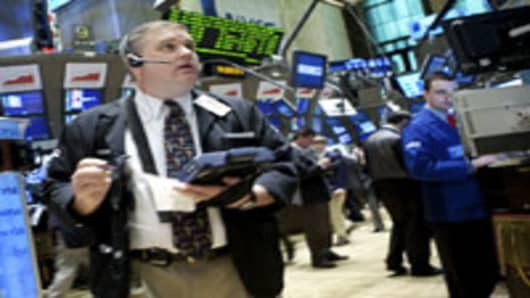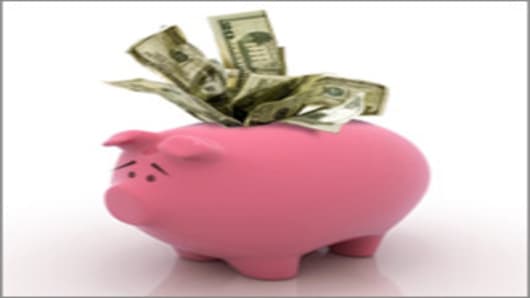More signs that the US economy is making a slow recovery are fueling worries that a market correction is in the works.
The Federal Reserve's decision Wednesday to keep interest rates low because of the weak economy took the air out of a stock market rallyand heightened concerns that some of Fed Chairman Ben Bernanke's "green shoots" were turning brown.
While no one is putting forth any doomsday scenarios—calling the low in March still seems a safe bet—the idea of a substantial summer pullback is gaining momentum.
"Slow growth and higher taxes—that's not a recipe for higher stocks," says Michael Pento, chief economist for Global Delta Advisors in Parsipanny, N.J. "The threat of a deflationary spiral is looking pretty good for now and that's what spooked the market."
The dour signs for the economy have been piling up lately. The White House on Monday conceded that 10 percent or worse unemployment is fairly inevitable, while the World Bank earlier that day predicted slow global growth.
At the same time, talk has accelerated for a Fed exit strategy from its onslaught of money easing and other liquidity measures. On top of all that, the Mortgage Bankers Association predicted far fewer originations this year than originally thought, and the National Association of Realtors said existing home sales in May gained less than expected, which was followed by a report that new home sales had unexpectedly decreased.
Wednesday's report on durable goods orders provided a brief respite from the gloom, but all of the economic noise has caused portfolio managers to start preparing for slower growth.
"The one thing that we can be sure of is that recoveries follow recessions. It's a safe bet that the economy will recover," says Peter J. Tanous, president and director at Lynx Investment Advisory in Washington, D.C. "What has to change are two things: 1) Our estimate of future growth. That may be a sea-change. It may not be as fast as thought. Secondly, how we build our portfolios to safeguard our original investment."
Investors who stayed heavily in stocks during the downturn lost portfolio value of 35 percent or more.
For Tanous, the steep, rapid slump should be a lesson that US investors were too weighted toward risk and leverage and need to rethink their strategies as the economy embarks on a journey that likely will take years before full recovery.
"Investors just got a punch to the gut," he says. "Did you learn anything? Are you going to listen to the people who say stocks are really cheap now? They are, and you should own them, but maybe you should own less of them than you used to."
Predictions vary as to how much of a pullback stocks will see, but the consensus seems to be around 10 percent.
- Real-Time Dow 30 Quotes
Linda Duessel, equity market strategist at Federated Investors in Boston, says the Standard & Poor's 500 could see as low as 830 but thinks the damage will be minimal and merely reflective of a natural retracement following the dramatic run-up.
"From an investing standpoint, the question I'm getting asked most often is, do you think it's too late to get in," Duessel says. "A pullback to the 800s might be a nice time to get in."
Some investment advisors say they are staying in stocks but are returning to quality after a whipsaw rally from March to June that saw the biggest gains in the hardest-hit sectors of the previous slump, a phenomenon that Morningstar analyst Paul Larson calls a "junk rally."
"As financial innovation goes into reverse a little bit and things get a little simpler, that's going to be a drag on economic growth at least for a few years," Larson says. "My strategy is to focus on the high-quality names, the ones that are going to be assured survivors."
That's a recurring theme from portfolio managers who are looking for strategies to pursue in the next wave of the market cycle. Many of them agree that the rally off the March lows is just about out of steam and are trying to position themselves going forward.
"We may see a 'W'-shaped recovery, and what happened between March and June was like the second line of the 'W,' " says Emily Sanders, president of Sanders Financial Management in Atlanta. "There could still be another leg down before we start heading out of this recession."
That doesn't mean investors shouldn't be putting some risk in their portfolios.
Rather, advisors are again focusing on dividend-paying stocks so there is some cushion against a drop in share price.
Tanous continues to like preferred shares and master limited partnershipsfor getting returns without all the risk, and advocates inflation protection through gold and Treasury Inflation Protected Securities.
Sanders sees value in dividends as well as emerging markets and some of the sectors that didn't participate as much in the recent rally, such as health care. In that space, she particularly advocates Israel's Teva Pharmaceutical, in which the Sanders firm holds a large position.
But gone, at least for now, is the big appetite for risk and leverage that helped inflate the market to its October 2007 highs, an area that probably won't be breached again for quite some time.
"Maybe stocks should be a lower portion of portfolios than thought," Tanous says. "We have to completely rethink risk, because we can't afford to lose 30 to 40 percent of our portfolio in 18 months."




